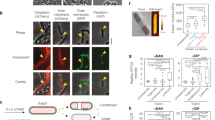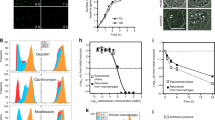Abstract
In log-phase cells of staphylococci, cultivated under high, “non-lytic” concentrations of penicillin G, there occurred a novel killing process hitherto hidden behind seemingly bacteriostatic effects. Two events are essential for the apprearance of this “hidden death”: (i) the failure of the dividing cell to deposit enough fibrillar cross-wall material to be welded together, and (ii) a premature ripping up of incomplete cross walls along their splitting system. “Hidden death” started as early as 10–15 min after drug addition, already during the first division cycle. It was the consequence of a loss of cytoplasmic constituents which erupted through peripheral slit-like openings in the incomplete cross walls. The loss resulted either in more or less empty cells or in cell shrinkage. These destructions could be prevented by raising the external osmotic pressure. In contrast, the conventional “non-hidden death” occurred only much later and exclusively during the second division cycle and mainly in those dividing cells, whose nascent cross walls of the first division plane had been welded together. These welding processes at nascent cross walls, resulting in tough connecting bridges between presumptive individual cells, were considered as a morphogenetic tool which protects the cells, so that they can resist the otherwise fatal penicillin-induced damages for at least an additional generation time (“morphogenetic resistance system”). Such welded cells, in the virtual absence of underlying cross-wall material, lost cytoplasm and were killed via ejection through pore-like wall openings or via explosions in the second division plane and after liberation of their murosomes, as it was the case in the presence of low, “lytic” concentrations of penicillin. Bacteriolysis did not cause any of the hitherto known penicillin-induced killing processes.
Similar content being viewed by others
References
Amako K, Umeda A (1984) Cross wall synthesis and the arrangement of the wall polymers in the cell wall of Staphylococcus spp. Microbiol Immunol 28: 1298–1301
Beise F, Labischinski H, Giesbrecht P (1988) Selective inhibition of penicillin-binding proteins and its effects on growth and architecture of Staphylococcus aureus. FEMS Microbiol Lett 55: 195–202
Blumberg PM, Strominger JL (1974) Interaction of penicillin with the bacterial cell: penicillin-binding proteins and penicillin-sensitive enzymes. Bacteriol Rev 38: 291–335
Eagle H, Musselman AD (1948) The rate of bactericidal action of penicillin in vitro as a function of its concentration, and its paradoxically reduced activity at high concentrations against certain organisms. J Exp Med 88: 99–131
Gerding DN, Peterson LR, Hughes CE, Bamberger DM, Larson TA (1991) Extravascular antimicrobial distribution and the respective blood concentrations in humans. In: Lorian V (ed) Antibiotics in laboratory medicine. Williams and Wilkins, Baltimore, pp 880–961
Giesbrecht P, Wecke J, Reinicke B (1976) On the morphogenesis of the cell wall of staphylococci. Int Rev Cytol 44: 225–318
Giesbrecht P, Morioka H, Krüger D, Kersten T, Wecke J (1983) Restoration of penicillin-damaged cell walls by de novo murein synthesis and successive murein degradation in staphylococci, revealing a hitherto unknown mechanism of penicillin action: blockage of autolytic wall processes by penicillin. In: Hakenbeck R, Höltje JV, Labischinski H (eds) The target of penicillin. de Gruyter, Berlin, pp 243–248
Giesbrecht P, Labischinski H, Wecke J (1985) A special morphogenetic wall defect and the subsequent activity of “murosomes” as the very reason for penicillin-induced bacteriolysis in staphylococci. Arch Microbiol 141: 315–324
Giesbrecht P, Kersten T, Wecke J (1992) Fan-shaped ejections of regularly arranged murosomes involved in penicillin-induced death of staphylococci. J Bacteriol 174: 2241–2252
Giesbrecht P, Franz M, Krüger D, Labischinski H, Wecke J (1993a) Bacteriolysis of staphylococci is only a side-effect of penicillin-induced death. In: Kleinkauf H, Döhren H von (eds) 50 Years of penicillin application-history and trends. Technische Universität Berlin, Berlin, pp 353–363
Giesbrecht P, Kersten T, Madela K, Grob H, Blümel P, Wecke J (1993b) Penicillin-induced bacteriolysis of staphylococci as a post-mortem consequence of murosome-mediated killing via wall perforation and attempts to imitate this perforation process without applying antibiotics. In: De Pedro MA, Höltje JV, Löffelhardt W (eds) Bacterial growth and lysis: metabolism and structure of the bacterial sacculus. Plenum Press, New York, pp 393–407
Hobby GL, Meyer K, Chaffee E (1942) Observations on the mechanisms of action of penicillin. Proc Soc Exp Biol Med 50: 281–288
Höltje J (1993) Das unverstandene Penicillin. D Apoth Z 133: 15–23
Koch A (1988) Biophysics of bacterial walls viewed as stress-bearing fabric. Microbiol Rev 52: 337–353
Labischinski H (1992) Consequences of the interaction of β-lactam antibiotics with penicillin-binding proteins from sensitive and resistant Staphylococcus aureus strains. Med Microbiol Immunol 181: 241–265
Labischinski H, Maidhof H, Franz M, Krüger D, Sidow T, Giesbrecht P (1988) Biochemical and biophysical investigations into the cause of penicillin-induced lytic death of staphylococci: checking predictions of the murosome model. In: Actor P, Daneo-Moore L, Higgins ML, Salton MRJ, Shockman GD (eds) Antibiotic inhibition of bacterial cell surface assembly and function. American Society for Microbiology. Washington DC, pp 242–257
Maidhof H, Johannsen L, Labischinski H, Giesbrecht P (1989) Onset of penicillin-induced bacteriolysis in staphylococci is cell cycle dependent. J Bacteriol 171: 2252–2257
McDowell TD, Lemanski CL (1988) Absence of autolytic activity (peptidoglycan nicking) in penicillin-induced nonlytic death in a group A streptococcus. J Bacteriol 170: 1783–1788
McDowell TD, Reed KE (1988) Hydrolysis of RNA during penicillin-induced nonlytic death in a group A streptococcus. In: Actor P, Daneo-Moore L, Higgins ML, Salton MRJ, Shockman GD (eds) Antibiotic inhibition of bacterial cell surface assembly and function. American Society for Microbiology, Washington DC, pp 231–241
Mitchell P, Moyle J (1956) Osmotic function and structure in bacteria. In: Spooner ETC, Stocker BAD (eds) Bacterial anatomy. Sixth Symposium of the Society for General Microbiology held at the Royal Institution, London. Cambridge University Press, Cambridge, pp 150–180
Murray RGE, Francombe WH, Mayall BH (1959) The effect of penicillin on the structure of staphylococcal cell walls. Can J Microbiol 5: 641–648
Nishino T, Wecke J, Krüger D, Giesbrecht P (1987) Trimethoprim-induced structural alterations in Staphylococcus aureus and the recovery of bacteria in drug-free medium. J Antimicrob Chemother 19: 147–159
Pickett-Heaps J (1977) Cell division and evolution of branching in Oedocladium (Chlorophyceae). Cytobiologie Eur J Cell Biol 14: 319–337
Prestige LS, Pardee AB (1957) Induction of bacterial lysis by penicillin. J Bacteriol 74: 48–59
Reinicke B, Blümel P, Labischinski H, Giesbrecht P (1985) Neither an enhancement of autolytic wall degradation nor an inhibition of the incorporation of cell wall material are pre-requisites for penicillin-induced bacteriolysis in staphylococci. Arch Microbiol 141: 309–314
Shockman GD, Daneo-Moore L, McDowell TD, Wong W (1981) Function and structure of the cell wall — its importance in the life and death of bacteria. In: Salton M, Shockman GD (eds) β-lactam antibiotics. Academic Press, New York, pp 31–65
Sidow T, Johannsen L, Labischinski H (1990) Penicillin-induced changes in the cell wall composition of Staphylococcus aureus before the onset of bacteriolysis. Arch Microbiol 154: 73–81
Tipper DJ, Strominger JL (1968) Biosynthesis of the peptidoglycan of bacterial cell walls. XII. Inhibition of cross-linking by penicillins and cephalosporins: studies in Staphylococcus aureus in vivo. J Biol Chem 243: 3169–3179
Wecke J, Giesbrecht P (1981) Electron microscopic studies on the “paradoxical” reaction of staphylococci during treatment with antibiotics. Zentralbl Bakteriol 10: [Suppl] 461–467
Author information
Authors and Affiliations
Additional information
Dedicated to Prof. Dr. Georg Henneberg on the occasion of his 85th birthday
Rights and permissions
About this article
Cite this article
Giesbrecht, P., Kersten, T., Maidhof, H. et al. A novel, “hidden” penicillin-induced death of staphylococci at high drug concentration, occurring earlier than murosome-mediated killing processes. Arch. Microbiol. 161, 370–383 (1994). https://doi.org/10.1007/BF00288946
Received:
Accepted:
Issue Date:
DOI: https://doi.org/10.1007/BF00288946




